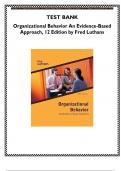Test Bank For Organizational Behavior- An Evidence-Based Approach 12th Edition by Luthans, All 14 Chapters Covered (NEWEST 2024)
TEST BANK
Organizational Behavior An Evidence-Based
Approach, 12 Edition by Fred Luthans
TEST BANK
,Test Bank For Organizational Behavior- An Evidence-Based Approach 12th Edition by Luthans, All 14 Chapters Covered (NEWEST 2024)
Organizational Behavior An Evidence-Based Approach, 12 Edition Fred Luthans Test Bank
Table of Content
Chapter 1: Introduction to Organizational Behavior: An Evidence-Based Approach
Chapter 2: Environmental Context: Globalization, Diversity, and Ethics
Chapter 3: Organizational Context: Design and Culture
Chapter 4: Organizational Context: Reward Systems
Chapter 5: Personality, Perception, and Employee Attitudes
Chapter 6: Motivational Needs, Processes, and Applications
Chapter 7: Positive Organizational Behavior and Psychological Capital
Chapter 8: Communication and Decision Making
Chapter 9: Stress and Conflict
Chapter 10: Power and Politics
Chapter 11: Groups and Teams
Chapter 12: Behavioral Performance Management
Chapter 13: Effective Leadership Processes
Chapter 14: Great Leaders: An Evidenced-Based Approach
,Test Bank For Organizational Behavior- An Evidence-Based Approach 12th Edition by Luthans, All 14 Chapters Covered (NEWEST 2024)
Full file at http://testbankinstant.CH/Test-Bank-for-Organizational- Behavior-An-Evidence-
Based-Approach-12th-Edition-Luthans-
Chapter 01
Introduction to Organizational Behavior: An Evidence-Based Approach
True / False Questions
1. The major challenge and critical competitive advantage for any organization is the human
resource of that company.
True False
2. Casey, a relationship manager in a bank creates value for her organization through her networks,
connections, and friends. These values can be referred to as "positive psychological capital."
True False
3. Roger, a sales manager for Heust Pvt. Ltd., is impressed with his new sales executive, Tim.
According to Roger, Tim is optimistic, can perform well under pressure, and is very confident about
what he does. These qualities can be referred to as "positive psychological capital." True False
4. The problems with human organizations and the solutions over the ages have undergone
drastic changes compared to their emphasis and surrounding environmental context.
True False
5. A paradigm establishes only written rules.
True False
6. ‘Paradigm shift' refers to the situation in which those in the existing paradigm may not even see the
changes that are occurring, and therefore, cannot analyze the changes.
True False
STUDYGUIDESOLUTIONS
, Test Bank For Organizational Behavior- An Evidence-Based Approach 12th Edition by Luthans, All 14 Chapters Covered (NEWEST 2024)
Full file at http://testbankinstant.CH/Test-Bank-for-Organizational- Behavior-An-Evidence-
Based-Approach-12th-Edition-Luthans-
7. Reasons for considerable resistance to change and difficulty to move from the old
management paradigm to the new can be explained by the "paradigm effect."
True False
8. The fact that today's managers are competent in their functional specialization is sufficient to
reiterate that most of them paid close attention to the conceptual and human dimensions of their
jobs.
True False
9. According to Theory X, if employees were kept happy, they would become high
performers.
True False
10. Theory X is the natural choice for most organizations in today's environment. True
False
11. Most of the practicing managers and their organizations cultures believe, fully implement, and
consistently adhere to a full-fledged HPWPs approach to management.
True False
12. The movement to not only recognize, but also do something about the "Knowing-Doing Gap"
is the movement towards evidence-based management.
True False
13. Most of the "new management practices" are essentially a readapted version of existing "old
management truths."
True False
STUDYGUIDESOLUTIONS




